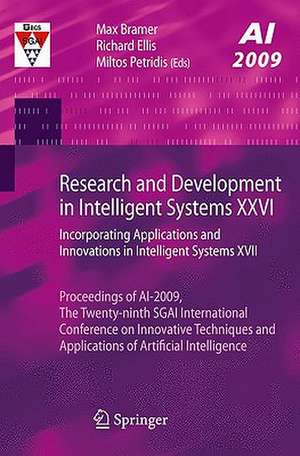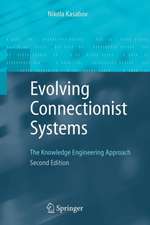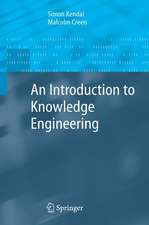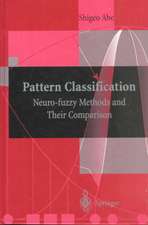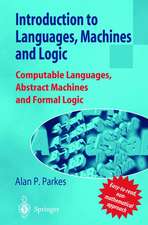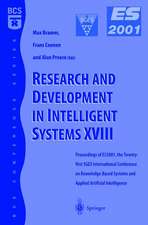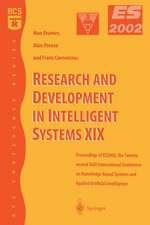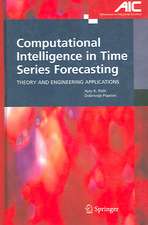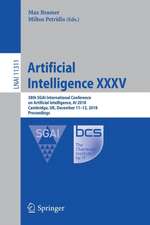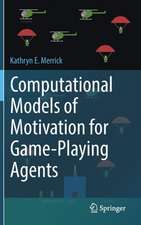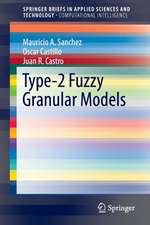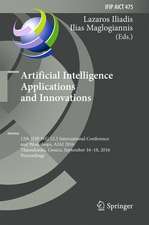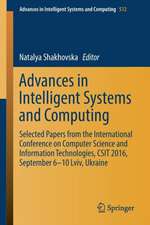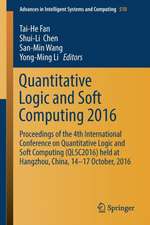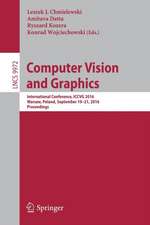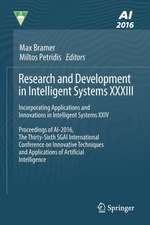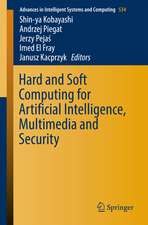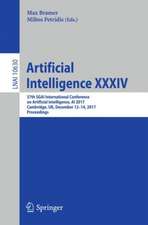Research and Development in Intelligent Systems XXVI: Incorporating Applications and Innovations in Intelligent Systems XVII
Editat de Richard Ellis, Miltos Petridisen Limba Engleză Paperback – 18 noi 2009
Preț: 1282.66 lei
Preț vechi: 1603.32 lei
-20% Nou
Puncte Express: 1924
Preț estimativ în valută:
245.47€ • 255.33$ • 202.65£
245.47€ • 255.33$ • 202.65£
Carte tipărită la comandă
Livrare economică 14-28 aprilie
Preluare comenzi: 021 569.72.76
Specificații
ISBN-13: 9781848829824
ISBN-10: 1848829825
Pagini: 522
Ilustrații: XVI, 504 p.
Dimensiuni: 156 x 234 x 35 mm
Greutate: 0.72 kg
Ediția:2010
Editura: SPRINGER LONDON
Colecția Springer
Locul publicării:London, United Kingdom
ISBN-10: 1848829825
Pagini: 522
Ilustrații: XVI, 504 p.
Dimensiuni: 156 x 234 x 35 mm
Greutate: 0.72 kg
Ediția:2010
Editura: SPRINGER LONDON
Colecția Springer
Locul publicării:London, United Kingdom
Public țintă
ResearchDescriere
The most common document formalisation for text classi?cation is the vector space model founded on the bag of words/phrases representation. The main advantage of the vector space model is that it can readily be employed by classi?cation - gorithms. However, the bag of words/phrases representation is suited to capturing only word/phrase frequency; structural and semantic information is ignored. It has been established that structural information plays an important role in classi?cation accuracy [14]. An alternative to the bag of words/phrases representation is a graph based rep- sentation, which intuitively possesses much more expressive power. However, this representation introduces an additional level of complexity in that the calculation of the similarity between two graphs is signi?cantly more computationally expensive than between two vectors (see for example [16]). Some work (see for example [12]) has been done on hybrid representations to capture both structural elements (- ing the graph model) and signi?cant features using the vector model. However the computational resources required to process this hybrid model are still extensive.
Cuprins
From the Contents:Coping with Noisy Search Experiences .- Knowledge Discovery and Data Mining.- A Sliding Windows based Dual Support Framework for Discovering Emerging Trends from Temporal Data.- A Classification-based Review Recommender.- Ontology – Driven Hypothesis Generation to Explain Anomalous Patient Responses to Treatment.- Reasoning.- Dual Rationality and Deliberate Agents.- Deriving Extensional Spatial Composition Tables.- A New Approach to Influence Diagrams Evaluation.- Analogical Proportions: Another Logical View.- Data Mining and Machine Learning.- Evaluating Clustering Algorithms for .- Genetic Regulatory Network Structural Inference.- Parallel Rule Induction with Information Theoretic Pre-Pruning.- A Kernel Extension to Handling Missing Data.- Temple Learning Using Wavelet Domain Statistical Models.- Optimisation and Planning.- Group Counseling Optimization: A Novel Approach.- Firefly Algorithm Levy Flight and Global Optimization.- Improving Cooperative Particle Swarm Optimization Using Fuzzy Logic.- Context-sensitive Plan Execution Language for Adaptive Robot Behaviour.- Knowledge Acquisition and Evolutionary Computation.- Explaining How To Play Real-Time Strategy Games.- On the Structure of a Best Possible Crossover Selection Strategy in Genetic Algorithms.- Chunking Natural Language Texts using Evolutionary Methods.- Short Papers.- Multi-Agent Reinforcement Learning- An Exploration Using Q-Learning.- Leverage Sub-class Partition Information in Binary Classification and Its Application.- A Linguistic Truth-Valuated Temporal Reasoning Formalism and Its Implementation.- Extending arc-consistency algorithms for Non-Normalized CSPs.- Remainder Subset Awareness for Feature Subset Selection.- An e-Manufacturing environment for Open Manufacturing Systems.-Best Application Paper.- Corpus Callosum MR Image Classificaton.-AI and Design.- Architectures by Design.-From Source to Code to Runtime Behaviour.-Learning to Improve E-mail calssification with numero interactive.- Commercial Applications of AI.- An Ai based System for Pricing Diverse Products and Services.- An Interval Type-2 Fuzzy Multiple Echelon Supply Chain Model.- Allocating Railway Platforms Using a Genetic Algorithm.- Further AI Applications.- An Optimal Dynamic Threat Evaluation and Weapon Scheduling Technique.- On AssistingVisual-Facial Affect Recgognition System with Keyboard-Stroke Pattern Information.- Feature Selection for Wheat Yield Prediction.- Short Papers.- Method of Combining the Degrees of Similarity in Handwrittten Signature Authentication Using Neural Networks.- Evolutionary Physical Model Design.- Decision Support in Designing with Polymers.- Cluster-based Benchmarking of Universities as an Alternative to League Tables.
Recenzii
From the reviews:“Papers and posters presented at the 29th SGAI International Conference on Innovative Techniques and Applications of Artificial Intelligence … are collected in this book. It presents a wide range of research topics. … Most of the papers have a quite formal approach. … They are all presented to professionals in AI, so the book should appeal to AI scholars and practitioners.” (G. Gini, ACM Computing Reviews, April, 2010)
Textul de pe ultima copertă
RESEARCH AND DEVELOPMENT IN INTELLIGENT SYSTEMS XXVI
INCORPORATING APPLICATIONS AND INNOVATIONS IN INTELLIGENT SYSTEMS XVII
The papers in this volume are the refereed papers presented at AI-2009, the Twenty-ninth SGAI International Conference on Innovative Techniques and Applications of Artificial Intelligence, held in Cambridge in December 2009 in both the technical and the application streams.
They present new and innovative developments and applications, divided into technical stream sections on Knowledge Discovery and Data Mining, Reasoning, Data Mining and Machine Learning, Optimisation and Planning, and Knowledge Acquisition and Evolutionary Computation, followed by application stream sections on AI and Design, Commercial Applications of AI and Further AI Applications. The volume also includes the text of short papers presented as posters at the conference.
This is the twenty-sixth volume in the Research and Development in Intelligent Systems series, which also incorporates the seventeenth volume in the Applications and Innovations in Intelligent Systems series. These series are essential reading for those who wish to keep up to date with developments in this important field.
INCORPORATING APPLICATIONS AND INNOVATIONS IN INTELLIGENT SYSTEMS XVII
The papers in this volume are the refereed papers presented at AI-2009, the Twenty-ninth SGAI International Conference on Innovative Techniques and Applications of Artificial Intelligence, held in Cambridge in December 2009 in both the technical and the application streams.
They present new and innovative developments and applications, divided into technical stream sections on Knowledge Discovery and Data Mining, Reasoning, Data Mining and Machine Learning, Optimisation and Planning, and Knowledge Acquisition and Evolutionary Computation, followed by application stream sections on AI and Design, Commercial Applications of AI and Further AI Applications. The volume also includes the text of short papers presented as posters at the conference.
This is the twenty-sixth volume in the Research and Development in Intelligent Systems series, which also incorporates the seventeenth volume in the Applications and Innovations in Intelligent Systems series. These series are essential reading for those who wish to keep up to date with developments in this important field.
